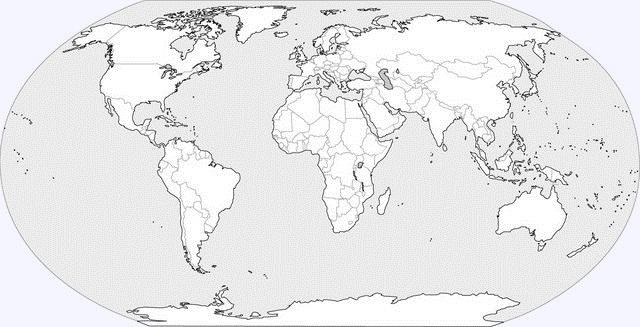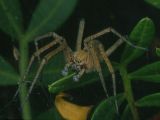|
Nombre común en ingles:
Orb Web
Spiders
Nombre común en castellano:
Se desconoce
Familias similares:
Género tipo:
Araneus Clerck, 1757
Diagnosis:
Small to large araneomorph spiders; three
tarsal, ecribellate, entelegyne; eight eyes in two rows with lateral
eyes widely separated from median eyes; labium rebordered; abdomen
globose, overhanging the carapace; legs usually with numerous spines
and sustentaculum on tarsus IV; male palp with mesal cymbium, median
apophysis and radix in the embolic division; an orb web a sticky
spiral, or a modification of such a web, is constructed.
Caracteres descriptivos:
Caparazón:
frequently flat; cephalic region usually separated from thoracic
region by oblique depresion; fovea distinct to absent. Esternón:
heart-shaped or triangular. Ojos: eight; in two rows (4:4);
lateral eye groups widely separated from median eyes; tapetum narrow
and shifted laterally in posterior median eyes. Quelíceros:
stong; vertical with lateral condyle; cheliceral furrow with two
rows of teeth. Piezas bucales: labium wider than long,
thickened anteriorly (rebordered); endites widest anteriorly. Patas:
three claws; legs usually furnished with numerous spines;
trichobothria present on all leg segments excep tarsi; tarsi IV with
sustentaculum. Abdomen: varies greatly; usually globose,
overhanging carapace; dorsum frequently with distinct pattern and
humps; covered with serrated setae; branchial opercula grooved. Hileras:
simple; with aggregatee silk gland spigots; posterior median
spinnerets with anterior field of aciniform gland spigots; colulus
present. Sistema respiratorio:
two booklungs; booklung covers grooved; tracheal spiracle close to
spinerets. Genitalia: entelegyne; epigyne completely or
partially sclerotized, frequently with a scapus; epigynal plate with
transverse furrows; male palp complex; femur often with basal
tubercle; patella often with two macrosetae; paracymbium usually a
sclerotized hook; median apophysis present; bulbus rotated within
cymbium. Tamaño corporal:
3-30 mm; sexual dimorphism in many genera, male then much smaller
than female (Caerostris; Gasterocantha). Color: varies
betwenn subfamilies, diurnal species usually more brightly coloured
than the greyish brow to dark brown nocturnal species.
Estatus taxonómico:
The Araneidae are considered sisters to all other Araneoidea. In a
more recent analysis (Kuntner, 2005, 2006), that place is taken by
the Nephilidae in the sense that they are positioned between the
Araneidae and the rest of the Araneoidea.
Distribución: The
Araneidae occur worldwide.

Estilo de vida:
Araneids are a diverse group of sticky orb-web weavers occupying a
wide range of habitats. Several genera (Cyrtarachninae) have reduced
webs or have entirely abandoned web building.
Bibliografía:
-
Davies,
V.T. 1988. An illustrated guide to the genera of orb-wearing
spiders in Australia. Mem. Qd. Mus. 25: 273-332.
-
Griswold,
C.E., Coddington, J.A., Hormiga, G. & Scharff, N. 1998.
Phylogeny of the orb-web building spiders (Araneae, Orbiculariae:
Deinopoidea, Araneoidea). Zool. J. Linn. Soc. 123: 1-99.
-
Levi, H.W.
2002. Keys to the genera of araneid orbweavers (Araneae,
Afraneidae) of the Americal. J. Arachnol. 30: 527-562.
-
Levi, H.W.
2005a. Araneidae. pp. 68-74 in Ubick, D., Paquin, P., Cushing,
P.E. & Roth, V. (Eds) 2005. The Spiders of North America. An
Identification Manual. American Arachnological Society.
-
Scharff,
N. & Coddington, J.A. 1997. A phylogenetic analysis of the
orb-weaving spider family Araneidae (Arachnida, Araneae). Zool.
J. Linn. Soc. 120: 355-434.
24 géneros y 61 especies presentes en la Península Ibérica:
|
| |
-
A. armida
(Audouin, 1826) |
| |
-
A. carbonaria
(L. Koch, 1869) |
| |
-
A. ceropegia
(Walckenaer, 1802) |
|
| |
-
A. redii
(Scopoli, 1763) |
|
| |
-
A. angulatus
Clerck, 1757 |
| |
-
A. circe
(Audouin, 1826) |
| |
-
A. diadematus
Clerck, 1757 |
| |
-
A. grossus
(C. L. Koch, 1844) |
| |
-
A. marmoreus
Clerck, 1757 |
| |
-
A. pallidus
(Olivier, 1789) |
| |
-
A. quadratus
Clerck, 1757 |
| |
-
A. sturni
(Hahn, 1831) |
| |
-
A. triguttatus
(Fabricius, 1793) |
| |
-
A. vulpinus
(Hahn, 1834) |
|
| |
-
A. alpica
(L. Koch, 1869) |
| |
-
A. cucurbitina
(Clerck, 1757) |
| |
-
A. inconspicua
(Simon, 1874) |
| |
-
A. opisthographa
(Kulczynski, 1905) |
|
| |
-
A. bruennichi
(Scopoli, 1772) |
| |
-
A. lobata
(Pallas, 1772) |
| |
-
A. trifasciata
(Forsskål, 1775) |
|
| |
-
C. prominens
(Westring, 1851) |
|
| |
- C. algerica
Simon, 1885 |
| |
- C. conica
(Pallas, 1772) |
| |
- C. groppalii
Pesarini, 1998 |
| |
- C. insulana
(Costa, 1834) |
| |
- C. oculata
(Walckenaer, 1802) |
| |
- C. sierrae Simon,
1870 |
|
| |
-
C. ixoides
(Simon, 1870) |
|
| |
-
C. citricola
(Forsskål, 1775) |
|
| |
-
G. bituberculata
(Walckenaer, 1802) |
| |
-
G. gibbosa
(Walckenaer, 1802) |
| |
-
G. omoeda
(Thorell, 1870) |
| |
-
G. ullrichi
(Hahn, 1835) |
|
| |
-
H. albovittata
(Westring, 1851) |
| |
-
H. heri
(Hahn, 1831) |
| |
-
H. pygmaea
(Sundevall, 1831) |
| |
-
H. sanguinea
(C. L. Koch, 1844)) |
|
| |
-
L. lineata
(Lucas, 1846) |
|
| |
-
L. cornutus
(Clerck, 1757) |
| |
-
L. patagiatus
(Clerck, 1757) |
| |
-
L. sclopetarius
(Clerck, 1757) |
| |
-
L. suspicax
(O. P.-Cambridge, 1876) |
|
| |
-
L. kochi
(Thorell, 1870) |
|
| |
-
M. acalypha
(Walckenaer, 1802) |
|
| |
-
N. laurae
(Simon, 1868) |
|
| |
-
N. adianta
(Walckenaer, 1802) |
| |
-
N. subfusca
(C. L. Koch, 1837) |
|
| |
-
N. umbratica
(Clerck, 1757) |
|
| |
-
P. montana
(C. L. Koch, 1834) |
|
| |
-
S. aussereri
Thorell, 1873 |
| |
-
S. hamata
(Clerck, 1757) |
| |
-
S. lucina
(Audouin, 1826) |
| |
-
S. neta
(O. P.-Cambridge, 1872) |
| |
-
S. nitidula
C. L. Koch, 1844 |
|
| |
-
S. dufouri
(Simon, 1874) |
|
| |
-
S. troemi
(Thorell, 1870) |
|
| |
-
Z. diodia
(Walckenaer, 1802) |
|
| |
-
Z. atrica
(Simon, 1868) |
| |
-
Z. keyserlingi
(Ausserer, 1871) |
| |
-
Z. x-nonata
(Clerck, 1757) |
| |
|
 |